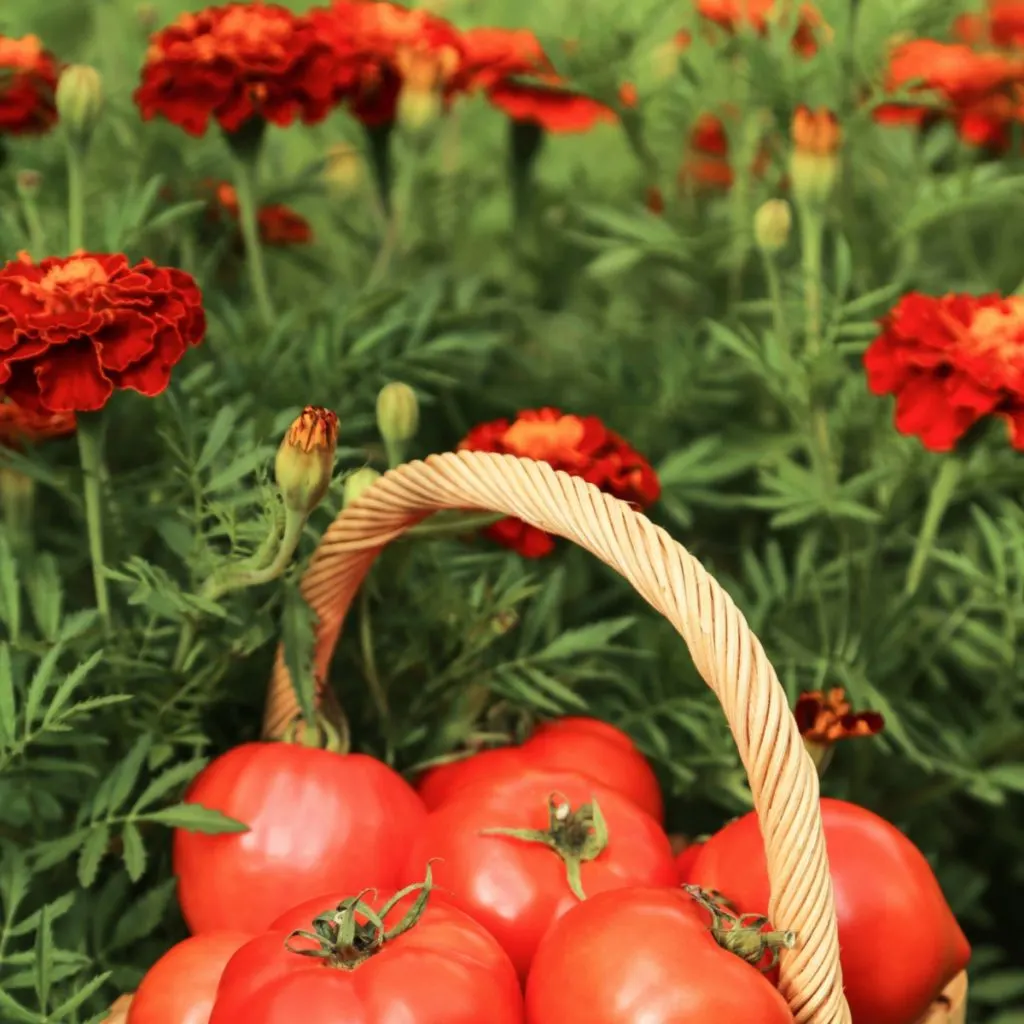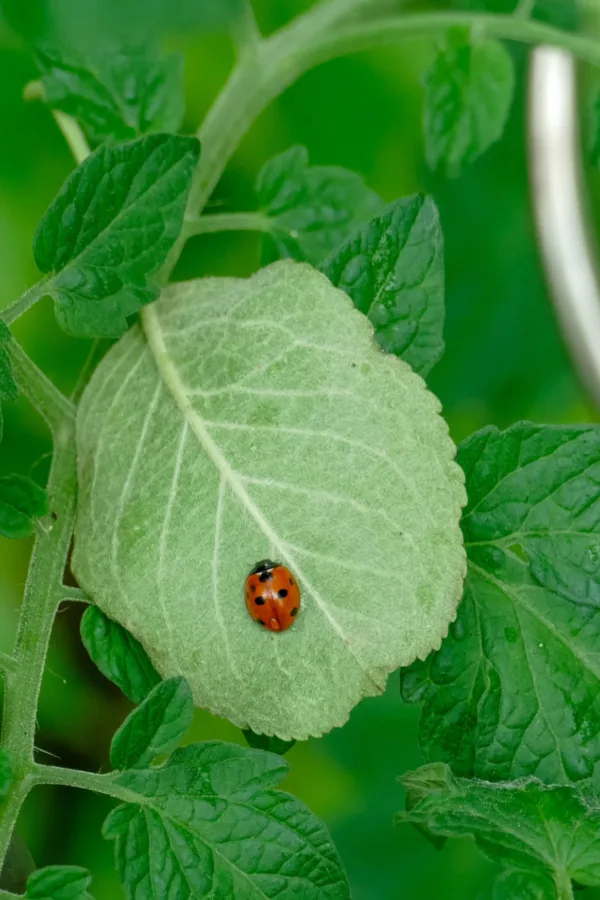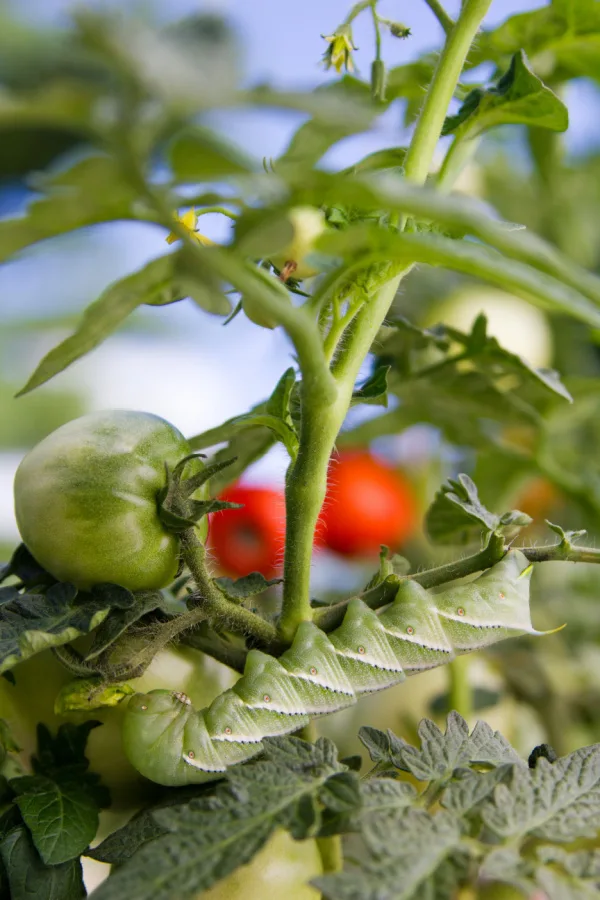If you are looking for a secret weapon in your garden this year to help boost your tomato plants to better health and bigger yields – you need to plant marigolds right along with them!
You might be surprised, but one of the best companion plants for tomatoes is the humble marigold. These vibrant annual flowers don’t just brighten up your garden with their bold colors—they also offer incredible benefits to tomato and other vegetable plants too!
Marigolds are some of the toughest annuals out there. They thrive in dry, hot conditions and are naturally resistant to pests and harsh weather. Unlike more delicate flowers like petunias or impatiens, marigolds can handle extreme environments – all without missing a beat.

Marigolds are incredibly resilient, with tough stems and leaves that can endure harsh conditions. Whether it’s scorching sun, dry spells, or strong winds that might damage other flowers, marigolds hold their ground with ease.
On top of that, marigolds are natural pest repellents. Animals like rabbits, deer, squirrels, and chipmunks steer clear of them, and they also deter many harmful insects.
The real magic, however, happens when you pair marigolds with tomato plants. That’s where their true benefits come to life, and as you will see below – exactly why you need to plant them together this year!
Why To Plant Marigolds With Tomato Plants
Marigolds Attract Pollinators
Marigolds attract pollinators like nobody’s business. Their bright flowers act as a natural magnet for a variety of beneficial insects, including honeybees, butterflies, and wasps. These insects are not only drawn to the marigold’s vibrant colors but also to the nectar they provide. And that can help to create more tomatoes on your plants!
While tomato plants have the ability to self-pollinate, they still need some assistance in transferring pollen within their flowers. Wind is a major help for sure, but the buzzing activity of pollinators also plays a crucial role.

As bees, butterflies, and wasps move from flower to flower in search of nectar, their bodies naturally brush against the plant’s pollen. This spreads the pollen from one bloom to another. This movement ensures that fertilization takes place, leading to healthier plants and a far more abundant tomato harvest.
Attracting Beneficial Insects
In addition to bringing in helpful pollinators, marigolds also attract insects that can help protect tomato plants from harm. Two of the most helpful of all that love marigolds are ladybugs and lacewings.
These beneficial bugs are a natural ally for tomato plants. And as such, they actively seek out and eliminate harmful pests such as aphids and whiteflies. Both of these tiny invaders can cause serious damage to tomato plants, especially when their populations explode.
Left unchecked, aphids and whiteflies reproduce rapidly, laying eggs that can then hatch to double and triple populations in mere days.
However, when marigolds are planted nearby, they create a welcoming environment for ladybugs and lacewings. These helpful insects are drawn to the marigold’s colorful flowers, but they don’t just stop for nectar. While in the area, they eagerly feast on aphids and whiteflies lurking on tomato plants, naturally keeping pest populations under control.
And remember those wasps that marigolds attract that help pollination? Those same wasps can also keep tomato hornworms at bay too!
Hornworms show up in the middle of summer and can destroy tomato plants fast. They don’t just eat the leaves but also chew into the tomatoes themselves. However, parasitic wasps love to lay their eggs on them. And once the baby wasps hatch, they feed on the hornworm, slowly killing it.
By simply adding marigolds to your garden, you’re encouraging these natural predators to stick around, providing an extra layer of protection for your tomato plants without the need for chemical pesticides.
Repelling Harmful Pests
If bringing in pollinators and beneficial insects wasn’t enough – marigolds also help repel some very bad pests too!
Marigolds have a strong smell that keeps whiteflies away. Even better, they also help keep mosquitoes at bay, making your time in the garden more comfortable. And those tomato hornworms? Marigolds not only attract wasps that attack hornworms, but they also help keep the worms from getting close to your tomato plants in the first place because hornworms don’t like their scent.
But marigolds do even more, as they also help keep out nematodes. Root-knot nematodes are one of the worst soil pests for tomato plants. These tiny organisms live underground and damage the plant’s roots.
In mild cases, they cause yellowing leaves and reduce the plant’s fruit production. In severe cases, they can completely kill the plant. The good news is that marigolds release a natural compound that destroys nematodes – and planting marigolds close to your tomatoes can help keep these pests under control effortlessly.

Growing Marigolds with Tomato Plants
Perhaps the best part of all is that planting marigolds with tomatoes is simple – and inexpensive. While you can buy marigold transplants at a garden center, they grow so easily from seeds, buying them isn’t really necessary. Affiliate Link: French Marigold Seeds
Marigolds sprout and grow quickly. If you plant seeds near your tomatoes in late spring, they will start growing in just a few weeks. You can then save seeds from the flowers to plant again next year – all for free! See our article: How To Easily Save Marigold Seeds.
As for how to plant, there several ways you can go. If you grow tomatoes in rows, you can plant marigolds as a border along the edges. Another option is to plant them around each tomato plant, spacing them about 18 inches from the stem. Some gardeners prefer to grow marigolds in pots and place them close to their tomatoes.
No matter how you grow them, keeping marigolds close to your tomato plants will help them work their magic. And one final note, although all marigold varieties are useful, French marigolds are especially good at keeping harmful bugs away and attracting beneficial insects.
It is the scent of French marigolds that is thought to be particularly effective – and for that reason, many gardeners prefer this variety over other marigold types. Affiliate Link: French Marigold Seeds
Here is to giving your tomato plants a big boost this year with marigolds – and to bigger yields than ever! When planting day arrives, be sure to check out The 4 Biggest Tomato Planting Mistakes – And How To Avoid Them!
Simple Garden Life
Follow Our Facebook Page For Even More Great Tips! Simple Garden Life Facebook Page
Simple Garden Life is a website dedicated to keeping gardening fun, simple and enjoyable! We publish two new articles each week along with a new garden podcast episode every two weeks. This article may contain affiliate links.
